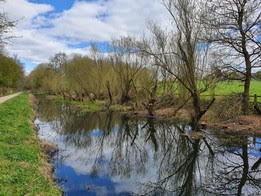Report from Broxtowe Borough Council
Some fairly urgent and extensive work on the canal from Mill Lane towards the former ski-slope was required where a number of leaks were getting worse. This work seems to have remedied the problem and Broxtowe Borough Council will now be looking to do some restoration works to the plant-life along this section, introducing a wider variety of native marginal and aquatic plants.
At the end of summer (when they can access the embankment from the cornfield) some of the thorn scrub will be removed – there are a lot of rabbits here and this is likely to make it less attractive to them, as the burrowing will all contribute to making the embankment less stable.
The plan is then to replant a hedge along the top of the embankment for the full length of this section, with small standard field maples in this hedge-line. The embankment will be kept open as a butterfly bank and planted with food and nectar plants for a range of pollinator species. There may be opportunities for volunteers to get involved, please contact mariegilbertcossall@gmail.com if you are interested in finding out more.

Further down adjacent the colliery spoil heap,over time the willow trees on the far bank of the Nottingham Canal had spread over the water and were almost reaching the towpath. Work has now taken place to prune them back to the main trunk.
The trees will now be maintained as “pollards”, with the new growth cut back to the trunk every few years. This is an ancient management technique for willow, with the pruned shoots being used in traditional basket weaving.
The work will keep the trees in check and the water open, with the pollard trunks providing an important habitat for nesting birds such as Marsh and Willow Tit. By opening the water up a wider variety of plants and animals will be able to colonise and already we have had promising signs that the endangered water vole has taken up residence!
Similar pollarding work is planned for the section of bank from Mill Lane towards Dead Lane later this year.